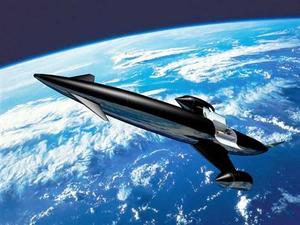Space plane that takes off from runway ready in 10 years
An unpiloted, air-breathing space plane that takes off from an airport runway and carries up to thirty passengers could be ready to fly in ten years; it will cost an estimated $12 billion to develop the space plane, and an additional $10 million per launch, compared to the approximately $150 million cost of a rocket launch; the company predicts that a trip to orbit for two weeks would cost tourists about $500,000 per seat

Artist's rendering of Skylon space plane in orbit // Source: msn.com
An unpiloted, air-breathing space plane that takes off from an airport runway, carries up to thirty passengers, and costs less than one-tenth to launch into space compared to a conventional rocket could be ready to fly in ten years, according to its developers, Oxfordshire, U.K.-baaed Reaction Engines.
The space plane is currently in the proof-of-concept phase, but the new U.K. Space Agency is hosting a workshop this week to discuss developing the space plane commercially. If successful, the space plane could be the first single-stage-to-orbit craft to reach orbit.
The Daily Mail’s Nial Firth writes that the space plane, called Skylon, is 82 meters long and has a 25-meter wingspan. Like an airplane, the space plane takes off and lands horizontally from a typical airport runway. Traveling at speeds of up to Mach 25, the vehicle could reach altitudes of 460 km (285 miles). It could carry payloads of up to 12 tons (twice that of a normal rocket), as well as about thirty passengers.
Skylon has no external rockets, but is propelled by two hybrid air-breathing/rocket engines that burn liquid hydrogen and liquid oxygen. In the first phase, the vehicle combines air from the atmosphere with on-board liquid hydrogen to reach speeds of Mach 5.5. In the second phase, on-board liquid hydrogen and liquid oxygen propel the vehicle to orbital velocities of Mach 25. Before take-off, the space plane weighs 275 tons, but only 55 tons when landing. The weight difference is due to the on-board fuel: at take-off, the vehicle carries about 66 tons of liquid hydrogen and 150 tons of liquid oxygen. Before re-entering the atmosphere, any unused liquid hydrogen is evaporated and vented overboard, since re-entry is easier for lighter vehicles.
Firth notes that it will cost an estimated $12 billion to develop the space plane (about the same amount that it costs to develop an Airbus jet). It would cost an additional $10 million per launch, compared to the approximately $150 million cost of a rocket launch. The company predicts that a trip to orbit for two weeks would cost tourists about $500,000 per seat.
For these reasons, Reaction Engines expects that Skylon could replace the space shuttles that travel to the International Space Station, as well as revolutionize space travel and offer the potential for space-based industry. The company predicts that there is a market for up to 70 reusable Skylon space planes worldwide.
“You can imagine a situation when some of our industrially important but polluting processes are done in space and the finished products are brought back down to Earth,” said Richard Varvill, technical director and one of the founders of Reaction Engines.
